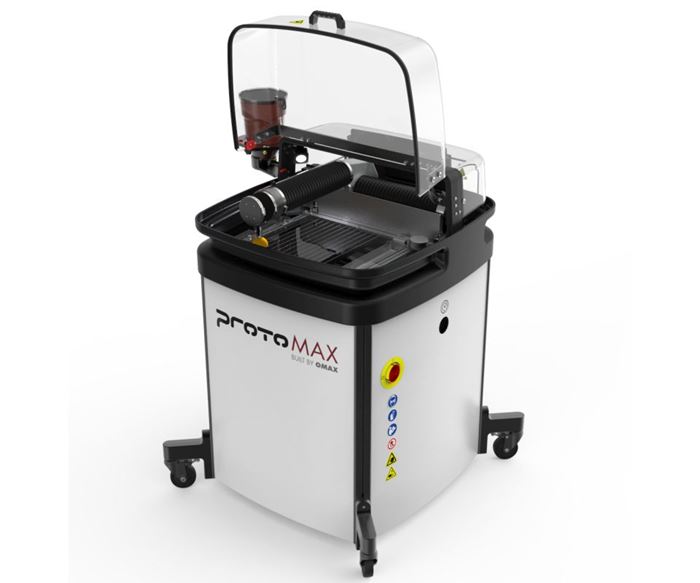The Personal Waterjet Cutting System Is a Natural Development
Much like what is happening with desktop 3D printing, Omax has developed a way to bring the versatility, capability and simplicity of waterjet cutting to a broader spectrum of users.
Share





ECi Software Solutions, Inc.
Featured Content
View More


Hwacheon Machinery America, Inc.
Featured Content
View More



.png;maxWidth=45)
DMG MORI - Cincinnati
Featured Content
View MorePerhaps no other material cutting process is as versatile, capable and simple as abrasive waterjet cutting. These qualities have made it a favorite for industrial users such as job shops and fabricators as well as for mobile repair centers, engineering classrooms, art studios and design houses. In an effort to make the technology even more versatile, Omax has now announced the release of a personal waterjet cutting system called the ProtoMax.
This system promises to make waterjet cutting feasible for a broad class of users for which versatility, capability, simplicity (and now affordability) are especially important. This group includes inventors, artists, teachers, engineers, prototypers, hobbyists, crafters and industrial users who need occasional waterjet capabilities to complement other cutting systems. The ProtoMax would not be out of place in a household setting. In fact, many of the same types of users who have already embraced various 3D printing and additive manufacturing processes in the maker movement are likely to take note of this new system.
Omax describes the new waterjet as a compact, self-installed cutting system suited for prototyping and relatively low-volume cutting of almost any material less than 2 inches thick in two-dimensional contouring. Aluminum, steel, composites, rubber, glass, granite, plastics, wood and other materials can be cut under the 30,000-psi cutting nozzle powered by a 5-hp pump. The maximum workpiece size is 12 inches by 12 inches. Abrasive waterjet cutting does not create a heat-affected zone, does not change material properties, creates little mist, and is relatively quiet at 76 decibels when cutting under water (about the same noise level as a garbage disposal or dishwasher). Other specs given for the ProtoMax include ±0.005-inch linear positioning accuracy, ±0.003-inch repeatability and a maximum 100-ipm traverse speed.
The system accepts the same garnet powder used in full-scale industrial systems. Because the garnet powder is available in proportionately smaller quantities appropriate for a unit of this size, the price per pound is somewhat higher. The hopper of the unit holds 14 pounds of powder. The lower stream pressure of the new system does reduce cutting speed compared to full-size machines, but this does not seem an obstacle for projects that fit the cutting table of the personal system.
The new waterjet plugs into a three-prong, 240-volt AC outlet such as one used for a home clothes dryer. The pump and cutting table are on casters, enabling the unit to be rolled into place.
As is the case for industrial models of abrasive waterjet cutting machines, programming software and the unit’s computer control system largely determine how readily the process can be implemented. For the ProtoMax, part programming and cutting operations are controlled by the company’s proprietary Intelli-Max software. According to Stephen Bruner, VP of marketing, the ProtoMax programming and control software are based on the same CAD/CAM software features of the industrial version. These features include waterjet cutting models that predict the behavior when cutting different materials, thicknesses and shapes. The user interface is said to be straightforward and appropriate for learning computer-aided manufacturing.
Mr. Bruner also notes that whereas most small industrial waterjets start at $70,000, the ProtoMax has a unit list price of $19,950.
Omax has launched a website to provide additional information about the personal waterjet system and purchasing options. The site includes design ideas, detailed specifications, frequently asked questions and a community section to support users and fellow enthusiasts. The first units are expected to be shipped by the end of 2017.
Related Content
How to Mitigate Chatter to Boost Machining Rates
There are usually better solutions to chatter than just reducing the feed rate. Through vibration analysis, the chatter problem can be solved, enabling much higher metal removal rates, better quality and longer tool life.
Read MoreCNC Machine Shop Honored for Automation, Machine Monitoring
From cobots to machine monitoring, this Top Shop honoree shows that machining technology is about more than the machine tool.
Read MoreInside the Premium Machine Shop Making Fasteners
AMPG can’t help but take risks — its management doesn’t know how to run machines. But these risks have enabled it to become a runaway success in its market.
Read More5 Tips for Running a Profitable Aerospace Shop
Aerospace machining is a demanding and competitive sector of manufacturing, but this shop demonstrates five ways to find aerospace success.
Read MoreRead Next
Registration Now Open for the Precision Machining Technology Show (PMTS) 2025
The precision machining industry’s premier event returns to Cleveland, OH, April 1-3.
Read MoreBuilding Out a Foundation for Student Machinists
Autodesk and Haas have teamed up to produce an introductory course for students that covers the basics of CAD, CAM and CNC while providing them with a portfolio part.
Read More5 Rules of Thumb for Buying CNC Machine Tools
Use these tips to carefully plan your machine tool purchases and to avoid regretting your decision later.
Read More










.png;maxWidth=150)


















.jpg;maxWidth=300;quality=90)
















